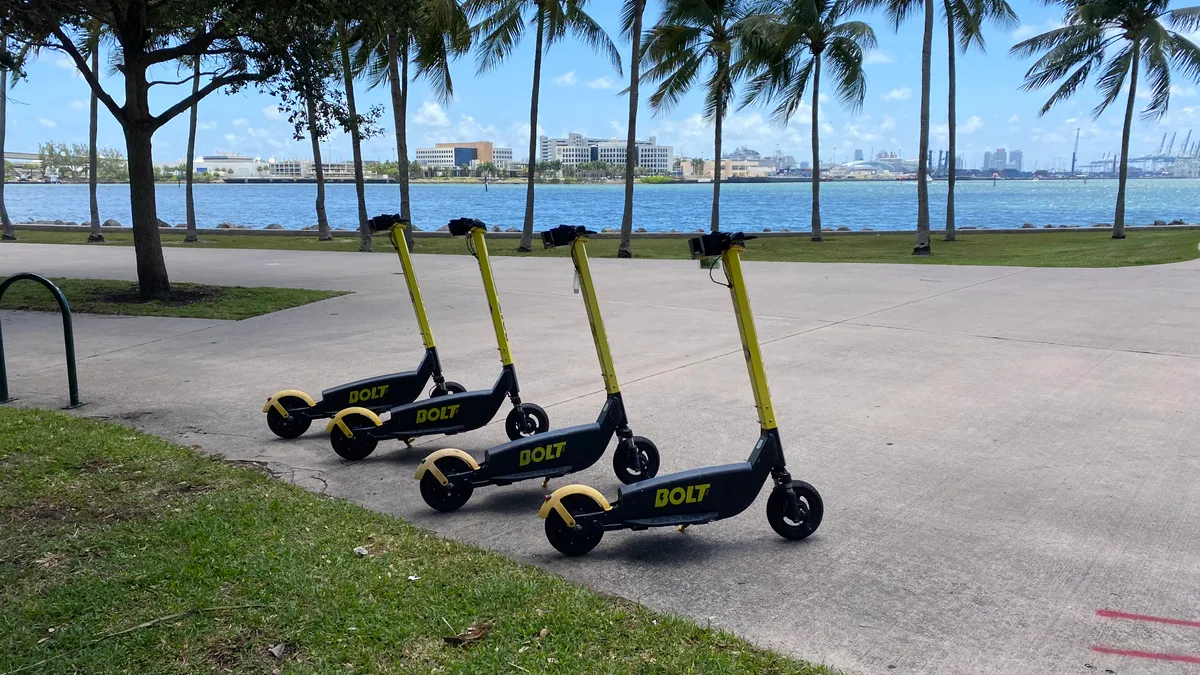Dive Brief:
- The Miami City Commission voted Monday to restore e-scooters to city streets with additional safety requirements less than two weeks after abruptly halting its micromobility program.
- In the earlier vote Nov. 18, the commission had ended its multiyear pilot program, which allowed vendors to operate scooter fleets in downtown areas. The vote came in response to safety concerns, with commissioners saying users were driving the vehicles too fast in crowded areas and the scooters were cluttering sidewalks.
- In the Monday special session, the commission voted 3-1 to rescind its previous vote, returning scooters immediately to the streets under new rules that will run through Jan. 5. The rules require riders to wear helmets and reduce the number of vehicles per block.
Dive Insight:
The decision earlier this month to yank scooters from Miami streets caught some operators flat-footed, especially given the government’s previous signals of support for micromobility. Mayor Francis Suarez had even praised the program just hours before the vote, telling attendees at the CoMotion LA conference that micromobility can reduce congestion and save time, the "most valuable asset each one of us have.” Fleet operators expressed frustration at the hasty decision and urged the city to reconsider, especially in advance of the holiday season, when Miami can see an influx of tourists.
Supporters have touted scooters as an effective way to beat traffic in one of the country's most congested cities. However, their presence has long been controversial. Miami officials have pulled them several times even while managing the pilot, including during the COVID-19 pandemic and for a brief period in early 2021 over clutter concerns.
The vote Monday will allow scooters to continue to operate through early December's Miami Art Week and through the holiday season. However, operators will face new safety rules and could face additional restrictions when the commission revisits the pilot. Commissioners weighed the best legal strategy to regulate the industry, and they could bring up new rules at a future commission meeting ahead of the pilot’s expiration.
"This news comes as a relief to Miami residents who've long relied on e-scooters as a safe, affordable and sustainable way to get around,” said Bruno Lopes, government relations manager for Lime, in a statement. “We look forward to working closely with the commissioners and Mayor Suarez to develop a permanent program that prioritizes safety for riders and non-riders alike. We specifically hope the city will continue to invest the millions of dollars in e-scooter fees Lime and other operators pay into protected bike lanes, the most proven way to ensure the safety of all road users."
According to city officials, the pilot has brought in approximately $2.5 million in fees operating companies have paid since spring of 2018. Under a plan from Miami-Dade county, $1 million of that has gone to fund protected bike and scooter lanes and other infrastructure upgrades.
Commissioner Manolo Reyes said he doesn't want the scooters in his district, saying “what they mostly do is clutter the sidewalk and make the sidewalk very dangerous.” Reyes also said that vehicles that had once been marketed as toys were likely to be driven unsafely and at high speeds. “Even at 10 miles per hour, that’s a speed that could hurt someone,” he said.
A key topic of discussion at Monday's special session was how and whether to require that riders wear helmets. Representatives of micromobility companies in attendance were split on how quickly a helmet mandate could be implemented and enforced. A representative for micromobility vendor Wheels, for example, said it can program its devices to operate only if helmets are worn. Ignacio Tzoumas, CEO of Bolt Mobility, said it would take two weeks to distribute helmets and put in place an enforcement mechanism, while a representative from Bird said that more helmets would have to be distributed or purchased before that mandate could be viable.
Commissioners decided a helmet mandate was necessary, however, and they opted to lower the number of allowed vehicles from four per operator per block to two. Commissioners and city officials said they would also explore speed limits and reducing operating hours.
The special session also addressed concerns about the distribution of vehicles around the city. Currently, scooters — and the infrastructure dollars they provide — are concentrated in the downtown district. However, Commissioner Alex Díaz de la Portilla said that leaves out poorer neighborhoods, which could also use vehicle access and the infrastructure funding benefit of the scooter fees. “There should be some redistribution,” Portilla said. “The whole county, the whole city should be getting revenue from this for sidewalk repair and street improvements.”
The debate in Miami reflects the work happening in cities across the country to adapt to the relatively new industry. Micromobility market players and analysts expect it to grow, but regulations continue to shift as cities weigh the sustainability and commuting benefits against safety concerns. “Change is coming. You can’t fight it. It’s going to happen anyway," Díaz de la Portilla said Monday.











